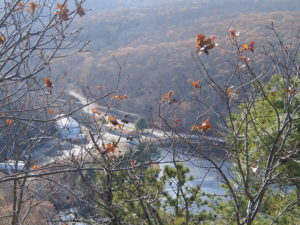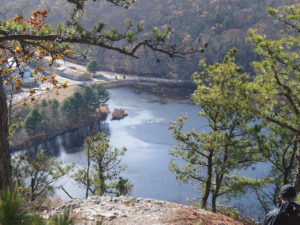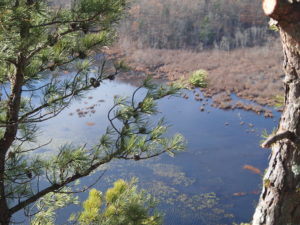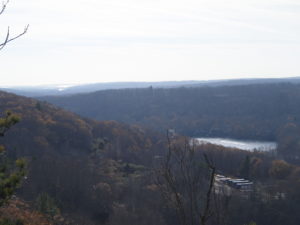Mabel Osgood Wright Style:
Hustle and bustle, chilly and windy! Scrape the dirty water and brush the dancing cattails, scrape all the silty soil and shine until neat. Hustle and Bustle, chilly and windy! Scaling is scary don’t get blown off your feet! Visitors beware you may have a good scare with a hawk above you observing…
…The plants and local species were all moving quickly, some largely due to the strong winds. The lake was full of algae and was likely a result from a small scale factory neighboring the water. The sky was clear and made for some fear as you scaled down the steep cliff. As you climbed down you could slip from either the silty soil or the strong winds… On days like that it added a sense of danger and adventure to the spot, making it even more appealing to me. The presence of humans was extremely prominet and the trees had adapted to defend their land. At the base of each tree was strong biodiversity to make up for the poor soil. The cattails were dancing in the wind along with the cedars, hemlocks, and various invasive species. The dance of the wind was the way of the land.
Mary Holland Style, Comparison:
The locations in Connecticut and Vermont have many similarities on purely just a ecology level, but once you dive into specifics you start to see lots of division. The soil type of my Connecticut spot has much less minerals and biodiversity inhabiting it as it isn’t on water. It looks out onto a (unhealthy) lake while my Vermont spot has water running directly through it. Comparing the local species is quite difficult as there is very little in both, but the do both share habitats for squirrels. What other species Vermont did have are long gone for the winter, they cannot survive the cold that awaits them. Similar to the lost species in Vermont, Connecticut has snakes that inhabit the area during the summer that slip away during the winter since their warm blood cannot survive in that type of cold. Connecticut has many hawks fly above scouring the land. As winter approaches both spots prepare by losing their leaves on deciduous trees. There are far many more conifers in Connecticut. Since my Connecticut spot is on protected Native American land the trees are much larger as they haven’t had to face nearly as much deforestation. That said, the personalities of the trees are just the same and are preparing for winter in similar ways. The two environments adapt and brace for winter in their own fashions and personalities.
https://www.google.com/maps/d/u/0/viewer?mid=19K4wTZN8Ascvm08KVkIhqetFCCZc22uP&ll=41.46374830000002%2C-71.94585319999999&z=17




